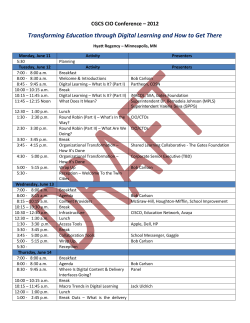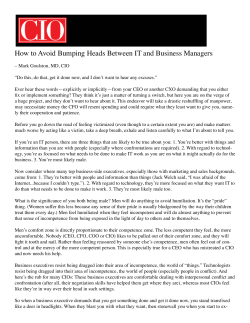
5. How to hire an IT Director [insert URL of FDs and IT article (3)] Directors are an increasingly important stakeholder in IT strategy within their organisations. In many
5. How to hire an IT Director We have seen from a previous article in this series [insert URL of FDs and IT article (3)] that Finance Directors are an increasingly important stakeholder in IT strategy within their organisations. In many cases FDs have overall control and accountability for IT, so given that technology is not a core competent of accountant’s training, it is important that FDs have a strong Chief Information Officer or IT Director to manage the day to day operations of IT, help align technology with business strategy and manage risk. Clearly the role of an IT director is more important than simply keeping the lights on, and so core technical skills need to be balanced with communications and business skills. But, to a certain extent the search for a ‘good’ or even ‘great’ IT Director is dependent on how engaged the Chief Executive or Finance Director responsible for IT are in the process and how much attention is paid at the top of the company on the role of It and its alignment with the business strategy. In order to become more engaged with the role of the IT Director, the first question to ask yourself is do you actually want one? It may seem a radical idea, but a lot of businesses are starting to seriously debate the strategic relevance of an IT Director. One argument is that if IT strategy is aligned to business strategy then an FD, MD, CEO or Operations Director should be adequately placed to cover this role. Furthermore, at a more fundamental level, the mechanics of IT can be covered off by IT managers and technical staff without the need of a board‐level IT specialist. In fact, latest statistics suggest that demand for IT directors is falling quite rapidly. According to a Computer Weekly/SSL survey of Sept 2007, there has been a fall in advertised UK IT Director vacancies of 31% compared with the previous quarter. Of course, one quarter does not make a trend, but the survey results come after Boots and House of Fraser confirmed in August that they would be rethinking the relevance of the IT Director role and handing full IT responsibilities to their CFOs. Recruitment specialists do not think the figures represent a long‐term decline in demand for IT directors and, for the majority of businesses, the IT Director role is still a central strategic and essential position within the organisation. Unfortunately most business people are apparently "clueless" when searching for IT Directors as illustrated by comments made by a senior CIO headhunter on the popular business IT news website www.silicon.com Cathy Holley, partner at headhunting company Boyden, said of CEOs: "If they are looking for a Finance Director they would probably know exactly what they are looking for, if they are looking for a sales and marketing director they'd probably know what they are looking for. When they are looking for a CIO ‐ generally speaking ‐ most of them are clueless." Holley added: "And they are clueless from the point of view that they have never seen a great CIO or they have seen a great CIO but can't articulate what it was about them that's really great." So what does make a great CIO or IT Director and what should you look for in the perfect candidate? The first thing to remember is that technical expertise in the nuts and bolts of IT is not a prerequisite of a strategic IT Director and many IT Directors and CIOs in large global businesses have very little technical knowledge or training in IT. The word ‘geek’ shouldn’t figure here. What is more important is a wider‐reaching contribution to the business, as long standing AstraZeneca CIO Paul Burfitt told Computer Weekly before his retirement in 2006: “It is very difficult to generalise what a CIO does, as there is no general CIO definition," Burfitt said. "It's what you do to add value to your business that counts.” So a good IT Director or CIO is a key contributor to the business moving forwards. Burfitt himself talks about how he doesn’t have direct hands‐on control of his company’s IT resources but does focus on its strategy. “I spend most of my time on the IT vision: the priorities, objectives and targets, and how IT contributes to deliver value to business. I have difficulty with the term 'IT strategy' because it separates IT strategy from business strategy.” Central to the role of any good IT Director is therefore communication – the ability to listen, analyse and coherently and succinctly communicate strategic objectives and company visions. As an FD, you also have be comfortable working with your IT Director on a day to day basis – they are not a back room techie, but a visible and essential stakeholder in ensuring your business drives sales, profitability and manages risk. As an FD, the IT Director should be a close personal ally and business partner – there is, after all, no information, no sales, no finance department and no ongoing business without IT. Commercial knowledge and business experience is also a must. It is often better to hire an IT Director with experience of delivering large business projects facilitated by IT (note that, echoing Burfitt above, the term ‘IT project’ should be looked upon with caution). Look carefully at candidates who have worked in related industries to yours but not necessarily the same sector as you don’t want an IT Director who will replicate the same strategy as your industry peers – where’s the competitive advantage in that? Lastly, deep understanding of the risk mitigation, compliance and IT governance are a necessity in a modern IT Director’s role where regulatory compliance and the fear of major IT disasters hitting the headlines have made management teams twitchy. As Burfitt says, “I was surprised to find I spend so much time on IT governance. We have been feeling there were too many reviews and debates which have been slowing us down.” Try to hire an IT Director who understands how to cut through red tape, who can organise effect steering committees and reporting lines to empower his or her employees to take responsibility for ensuring IT is accountably, can prove compliance with systems and process, but also is unbureaucratic and apolitical in doing so. This is all very well, but by their own admission many IT Directors lack the sum of these skills. As the CIO Jury – a group of 12 CIOs brought together by www.silicon.com – stated in June 2007: “We are our own worst enemies because we don’t as a group talk the language of business. Three out of four IT Directors will talk techie to their board.” Often IT directors are hired from within their companies which can contribute to the problem, as Michael Elliot, IT Director at Hasbro notes at the CIO Jury: “The people who rise up through the ranks don’t necessarily gain those sort of skills as they progress.” So if you don’t identify those skills in your IT managers coming through the ranks then you as FDs and business people should think about offering communications and change management training to your bright young things in IT. In the meantime you might want to look outside your business for an IT leader – change and new perspectives are always a good thing, and to be true agents of change, IT Directors need to be brilliant communicators and business people. They should be driven by a passion for innovation and not implementation; they need to be leaders of teams and self‐ critical but not pessimistic about the returns that IT can deliver. Applicants with a blinkered focus on technology need not apply. Further reading Boots and House of Fraser decision to rethink the role of its IT Director is analysed here http://www.computing.co.uk/computing/news/2196230/retailers‐rethink‐director‐role http://www.theregister.co.uk/2007/08/13/it_director_questions/ CIO Jury articles are available at www.silicon.com/ciojury www.cioupdate.com contains many articles and guidance notes on the strategic role of the CIO A very useful article on what CEOs are looking for in CIO applicants, based on comments by Holley, is available here http://www.computerweekly.com/Articles/2006/10/03/218755/what‐does‐the‐ceo‐ want‐from‐you.htm What’s in an IT name? With comments from Paul Burfitt: http://www.computerweekly.com/Articles/2003/03/26/193390/whats‐in‐an‐it‐name.htm
© Copyright 2025





















